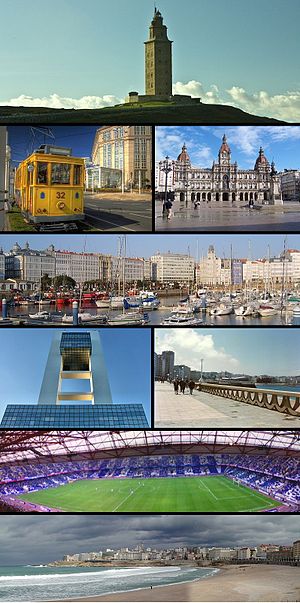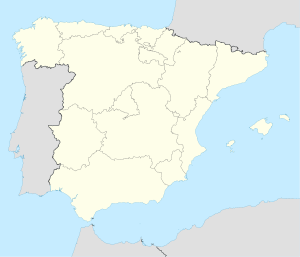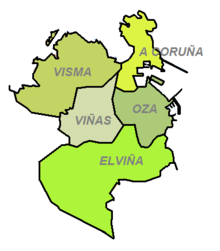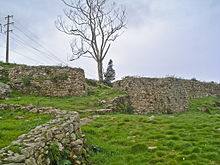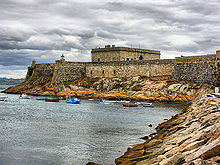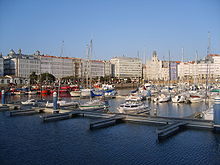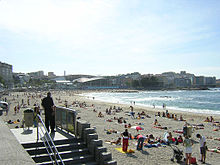- A Coruña
-
A Coruña
La Coruña— City — 
Coat of armsNickname(s): A cidade de cristal (The Glass City), "Marineda" Motto: A Coruña, a cidade onde ninguén é forasteiro (A Coruña, the city where nobody is a stranger) Location of the municipality of A Coruña within Galicia Location of A Coruña within Spain Coordinates: 43°22′17″N 8°23′45″W / 43.371491°N 8.395970°WCoordinates: 43°22′17″N 8°23′45″W / 43.371491°N 8.395970°W Country Spain Region Galicia Province A Coruña County A Coruña Parishes A Coruña, Elviña, Oza, San Cristovo das Viñas, Visma Government - Type Mayor-council - Body Concello da Coruña - Mayor Carlos Negreira (PPdeG) Area - City 37.83 km2 (14.6 sq mi) Population (2008)INE - City 246,056 - Density 6,613/km2 (17,127.6/sq mi) - Metro 419,800 Demonym Corunnan
coruñés (m), coruñesa (f)Time zone CET (GMT +1) - Summer (DST) CEST (GMT +2) (UTC) Postcode 15001-15011 Area code(s) +34 981 Website coruna.es A Coruña or La Coruña or A Corunha (still sometimes known as Corunna in English, and archaically as The Groyne) is a city and municipality of Galicia, Spain. It is the second-largest city in the autonomous community and seventeenth overall in the country. The city is the provincial capital of the province of the same name, having also served as political capital of the Kingdom of Galicia[1][2] from the XVIth to the XIXth centuries, and as a regional administrative centre between 1833 and 1982, before being replaced by Santiago de Compostela.
A Coruña is a busy port located on a promontory in the entrance of an estuary in a large gulf (the Portus Magnus Artabrorum of the classical geographers) on the Atlantic Ocean. It provides a distribution point for agricultural goods from the region. Although much of the heavy industry is based on the shipyards and metalworks of the neighbouring city of Ferrol, there is an oil refinery in A Coruña itself.
Contents
Name
In English, use of the Spanish or Galician forms now predominates. However, the traditional form Corunna can still be found, particularly in reference to the Battle of Corunna in the Peninsular War. Archaically, the city was known as The Groyne, probably from French "La Corogne", although this name could also be as much a geographical description given the city occupies a small peninsula protruding out into the Atlantic.[3]
In Spain, currently the only official form of the name is the Galician one, "A Coruña".[4] Nonetheless, the Spanish form, La Coruña, is still widespread, and it is the traditional name in Spanish recommended by the Real Academia Española for texts in Spanish.[5] It is usually used in extra-official documents and in conversations between Spanish-speakers.[citation needed]
Now several groups of people are advocating elevating the form "A Corunha" to official status, pointing to the provisions of the Spanish Constitution of 1978. They claim that the Constitution is violated by not allowing freedom of use, another orthography, to name a city in official documents, and that no Autonomous Regional law can prevail over the Constitution.[citation needed] Nevertheless, the Local Regime Law, a state law, stipulates that the name of the municipalities can be in Spanish, regional language or both, so it is totally legal and constitutional that the only official form of the name is the Galician one.[6]
Origin
There is no clear evidence as to what word the name derives from. It seems to be from Crunia, of unknown origin and meaning. At the time of Ferdinand II of León (12th century) the name Crunia was documented for the first time. As usual in Galician-Portuguese (as well as in Castilian Spanish), the cluster ni naturally evolved into the sound [ɲ], written n or nn in old Galician orthography, nn (later abbreviated to ñ, as well as the original Latin cluster "nn") in Spanish, and nh in Portuguese. 'A' is the Galician article equivalent to English 'the'; compare Castilian Spanish 'La' ('the').
A more poetic explanation sustains that "Coruña" derives from Gaelic (the language of Celtic tribes) "Cork Orunnach", which would mean "The harbour of the brave men". However, this explanation could have some relation to the Lebor Gabála Érenn (The Book of the Taking of Ireland), which recounts the story of how the Celtic or Milesian king Breogan founded the city of Brigantia (now Coruña) here and his descendants Ith who spies Ireland from the top of Breogán's Tower (thought to have been at the current location of the Torre de Hercules), journeys north across the Celtic Sea to Ireland to investigate his discovery.
A proposed etymology derives Crunia from Cluny, the town and religious order from France. During its height (c. 950–c.1130) the Cluniac movement was one of the largest religious forces in Europe. There is another town named Coruña in Burgos Province.
A folk etymology incorrectly derives Coruña from the ancient columna, or Tower of Hercules, which still exists, having been converted into a light-house in 1791.[7]
Geography
A Coruña is located on a peninsula, and its isthmus was at times formed only by a small strip of sand. Erosion and sea currents caused a progressive accumulation of sand, enlarging it to its present dimensions.
A Coruña is one of only eight pairs of cities in the world that has a near-exact antipodal city. Half of these antipodal pairs are in Spain/Morocco and New Zealand – with Christchurch, New Zealand as A Coruña's antipode.
Administrative divisions
A Coruña has five parroquias: A Coruña, Elviña, Viñas, Visma, Oza.
Suburbs
- Cidade Vella
- A Mariña
- Os Cantóns
- Pescadería
- O Ensanche
- Cidade Xardín
- Catro Camiños
- A Gaiteira
- Os Mallos
- Zalaeta
- As Atochas - Monte Alto
- Falperra – Santa Lucia
- Juan Flórez – San Pablo
- Os Castros
- Agra do Orzán
- Sagrada Familia
- Labañou – San Roque
- Barrio das Flores
- Elviña
- O Ventorrillo
- Castrillón
- Adormideras
- O Birloque
- Matogrande
- Os Rosales
- Paseo das Pontes
- Mesoiro
- Novo Mesoiro
- Someso
- Vioño
- Eirís
- Monelos
- San Pedro de Visma
- Bens
- A Silva – San Xosé
- Palavea
- Casablanca – As Xubias
- Feáns
- A Zapateira
- Santa Margarida
Climate
The climate of A Coruña is temperate maritime and heavily moderated by the Atlantic Ocean. In short, the climate more closely resembles the oceanic climate that is common in the Pacific Northwest region of North America. Autumn and winter are often unsettled and unpredictable with strong winds and abundant rainfall, coming from Atlantic depressions and it is often overcast. The ocean keeps temperatures mild, and frost and snow are rare. In summer, it is quite dry and sunny with only occasional rainfall, temperatures are warm but rarely uncomfortably hot due to the sea's cooling influence during the day. Spring is usually cool and fairly calm.
Climate data for A Coruña Month Jan Feb Mar Apr May Jun Jul Aug Sep Oct Nov Dec Year Average high °C (°F) 13.1
(55.6)13.7
(56.7)14.9
(58.8)15.5
(59.9)17.4
(63.3)19.8
(67.6)21.8
(71.2)22.5
(72.5)21.5
(70.7)18.7
(65.7)15.8
(60.4)14.0
(57.2)17.4 Daily mean °C (°F) 10.4
(50.7)10.9
(51.6)11.8
(53.2)12.5
(54.5)14.4
(57.9)16.8
(62.2)18.7
(65.7)19.3
(66.7)18.2
(64.8)15.7
(60.3)13.1
(55.6)11.5
(52.7)14.4 Average low °C (°F) 7.6
(45.7)8.0
(46.4)8.6
(47.5)9.4
(48.9)11.4
(52.5)13.7
(56.7)15.6
(60.1)16.0
(60.8)14.8
(58.6)12.6
(54.7)10.3
(50.5)8.9
(48.0)11.4 Precipitation mm (inches) 128
(5.04)102
(4.02)79
(3.11)85
(3.35)80
(3.15)42
(1.65)30
(1.18)35
(1.38)68
(2.68)110
(4.33)114
(4.49)135
(5.31)1,008
(39.69)Avg. precipitation days 17 17 15 17 16 10 8 9 11 16 17 18 171 Sunshine hours 108 112 155 167 191 220 240 240 179 150 107 93 1,966 Source: World Meteorological Organization (UN),[8] Agencia Estatal de Meteorología[9] History
Prehistory
A Coruña spread from the peninsula where the Tower of Hercules stands, onto the mainland. The oldest part, known popularly as Cidade Vella (Old City), Cidade Alta (High City) or the Cidade (City), is built on an ancient Celtic castro. It was supposedly inhabited by the Artabrians, the Celtic tribe of the area.
Roman times
The Romans came to the region in the 2nd century BC, and the colonisers made the most of the strategic position and soon the city became quite important in maritime trade. In 62 BC Julius Caesar came to the city (known at the time as Brigantium) in pursuit of the metal trade, establishing commerce with the regions that would eventually be France, England and Portugal. The town began growing, mainly during the 1st and 2nd centuries (when the Farum Brigantium Torre de Hércules was built), but declined after the 4th century and especially with the incursions of the Normans, which forced the population to flee towards the interior of the Estuary of O Burgo.
Middle Ages
After the fall of the Roman Empire, A Coruña still had a commercial port connected to foreign countries, but contacts with the Mediterranean were slowly replaced by a more Atlantic-oriented focus. The process of deurbanization that followed the fall of the Roman Empire also affected A Coruña. Between the 7th and 8th centuries, the city was no more than a little village of laborers and sailors.
The 11th-century Chronica iriense names Faro do Burgo (ancient name of A Coruña) as one of the dioceses that king Miro granted to the episcopate of Iria Flavia in the year 572:
- "Mirus Rex Sedi suae Hiriensi contulit Dioceses, scilicet Morratium, Salinensem, (...) Bregantinos, Farum..."
- "[King Miro granted to his Irienses headquarters the dioceses of Morrazo, Salnés (...). Bergantiños, Faro...]"
The Muslim invasion of the Iberian peninsula left no archeological evidence in this area, so it cannot be said whether or not the Muslim invaders ever reached the city. As Muslim rule in early 8th century Galicia consisted little more than a short-lived overlordship of the remote and rugged region backed by a few garrisons, and the city was no more than a village amidst Roman ruins, the invaders showed the same lack of interest in the ruined city as they did generally for the region.
As the city began to recover during the Middle Ages the main problem for the inhabitants was the Norman raids, as well as the ever present threat of raids ("razzies") from Al-Andalus to the south. During 9th century there were several Viking attacks on the city, called at that time Faro or Faro Bregancio.
In the year 991, King Vermudo II began the construction of defensive military positions on the coast. At Faro, in the ruins of the Tower of Hercules, a fortress was built, which had a permanent military garrison. To pay for it, he gave power over the city to the bishop of Santiago. The bishop of Santiago became the most important political post in Galicia, and remained so until the 15th century.
In 1208, Alfonso IX re-founded the city of Crunia. Some privileges, such as those of disembarking and selling salt without paying taxes, were granted to the city, and it enjoyed a big growth in fishing and mercantile business. The city grew and extended through the isthmus. In 1446 John II of Castile granted to A Coruña the title of "City". The Catholic Monarchs established the Royal Audience of the Kingdom of Galicia in the city, instead of Santiago. A Coruña also became the headquarters of the Captaincy General.
Modern period
During the Modern period, the city was an important port and centre for the manufacturing of textiles. In 1520, king Charles I of Spain (future Emperor Charles V of Germany), met in the Courts of A Coruña and embarked from its harbor to be elected Emperor. Charles I allowed the Government of the Kingdom of Galicia to distribute space in Europe between 1522 and 1529. Commerce with the Indies was allowed between 1529 and 1575. The Castle of San Antón was built as a defense of the city and its harbour.
From the port of Ferrol in the Province of A Coruña, Philip II left to marry Mary Tudor in 1554, and much later, in 1588, from the same port the Spanish Armada would set sail to the Spanish Netherlands and England. In the following year, during the Anglo-Spanish War, Francis Drake besieged A Coruña, but was repelled, starting the legend of María Pita, a woman who took her dead husband's weapon and continued shooting until she captured a flag of the British enemy.
In the 16th and 17th centuries, the wars of the Spanish monarchy caused a great increase in taxes and the start of conscription. In 1620, Philip III created the School of the Boys of the Sea. In 1682 the Tower of Hercules was restored by Antúnez.
19th century
A Coruña was the site of the Battle of Corunna during the Peninsular War, on 16 January 1809, in which British troops fought against the French to cover the embarkation of British troops after their retreat. In this battle Sir John Moore was killed.
Spanish resistance during the Peninsular War was led by Sinforiano López, and A Coruña was the only Galician city that achieved success against the French troops. French troops left Galicia at the end of May 1809.
During the 19th century, the city was the centre of anti-monarchist sentiment. On August 19, 1815, Juan Díaz Porlier, pronounced against Fernando VII in defense of the Spanish Constitution of 1812. He was supported by the bourgeoisie and the educated people. But on August 22 he was betrayed. He was hanged in the Campo da Leña two months later. In all the 19th-century rebellions, A Coruña supported the liberal side. A Coruña also played an important role in the Rexurdimento, and there were founded the Galician Royal Academy in 1906 and the Brotherhoods of the Galician Language in 1916.
Regarding the economy, in 1804 the National Cigarette Factory was founded, and there the workers' movement of the city had its origins. During the 19th century other businesses (glass, foundries, textiles, gas, matches, etc.) were slowly established, but it was maritime trade and migrant travel that attracted Catalan, Belgian, French and English investments. The Bank of A Coruña was founded in 1857. The new provincial division of 1832 also influenced economic development.
20th century
At the beginning of the 20th century, A Coruña had about 45,000 inhabitants. The Great Depression, Spanish Civil War severely affected the economy through the 1930s to the mid 1950s. The 1960s and early 1970s saw a dramatic economic recovery, which was part of the wider Spanish Miracle. The international oil shocks of the mid and late 1970s severely disrupted the economy, causing many bankruptcies and high unemployment until the mid 1980s, when slower but steady economic development was resumed.
Elections of 1931
In the Spanish general elections, 1931, all the political parties knew that the electoral results had important political consequences. The campaign of Unión Monárquica was very important in A Coruña and was supported by El Ideal Gallego. Republicans and socialists constituted a block, made up of ORGA, independent republicans, Spanish Socialist Workers' Party (PSOE) and the Radical Socialist Republican Party.
In the elections, the republican parties obtained 34 of the 39 council seats. The best results were of the ORGA and of the Partido Radical Socialista, and the Radical Republican Party lost a lot of support.
Democracy returns
From 1983 to 2006, the mayor of the city was Francisco Vázquez Vázquez (PSOE), and the city became devoted to services, but he also was criticised because of his being openly against Galician nationalism and his town-planning policies.
On January 20, 2006 Vázquez was named ambassador to the Vatican City, and was later replaced by Francisco Javier Losada de Azpiazu. In 2007 Municipal Elections the local government was a coalition of the Socialist Party of Galicia and the left-wing nationalist Galician Nationalist Bloc party.
The city celebrated it's first millenium in 2008.
In the 2011 Municipal Elections, the conservative candidate Carlos Negreira (PP) obtained a majority, the first one for the People's Party in the city since the arrival of democracy.
Population
The province and city of A Coruña during the 20th century
After the Battle of Trafalgar (1805) and the War of Independence (1808–1814), the fortunes of Ferrol began to deteriorate. The largest port in northern Spain, site of one of the three Royal Dockyards, together with Cartagena and Cadiz, almost became a "dead" town during the reign of Ferdinand VII. By 1833 the City and Naval Station of Ferrol saw its civilian population reduced to just 13,000.[10] During the administration of the Marquis de Molina, Minister for Naval affairs in the mid-19th century new activities sprang up, but Ferrol never fully returned to its former glories. It should be noted that during those years, most of the Spanish Colonies in Latin America succeeded in gaining independence from their former metropolis.
The population of the City of A Coruña in 1900 reached 43,971, while the population of the rest of the province including the City and Naval Station of nearby Ferrol as well as Santiago de Compostela was 653,556.[11] A Coruña's miraculous growth happened during aftermath of the Spanish Civil War at a similar rate to other major Galician cities, but it was after the death of Francisco Franco when the city of A Coruña (and Vigo) left all the other Galician cities behind.
The miraculous meteoric increase of population of the city of A Coruña and to a lesser degree Ferrol and Santiago de Compostela, during the years which follow the Spanish Civil War during the mid 20th century, can only be explained when we see the figures of the number of villages and hamlets of the province which disappeared or nearly disappeared during the same period. We are talking here about an economic revolution or substantial increase in living standards and not so much to an explosion of births, which has happened too, but looking to the overall picture what has happened is that the fields have been abandon due to the introduction of new machinery and most of the population has moved to find jobs in the main cities increasing the number of people working in the Tertiary and Quaternary sectors.
The city today
City's Metropolitan area 2010 District Population Coruña 246,047 Culleredo 28,737 Arteixo 30,255 Oleiros 33,550 Sada 14,734 Bergondo 6,758 Abegondo 5,765 Cambre 23,621 Carral 5,945 The municipality of A Coruña has 246,047 inhabitants, and has one of the highest population densities of Spain and Europe, with around 6,700 inhabitants per square kilometer.
In 2010 there were 12,344 foreigners living in the city, representing a 5% of the total population. The main nationalities are Brazilians (10%), Colombians (8%) and Peruvians (7%).
By language, according to 2008 data, 7,75% of the population speak always in Galician, 36% speak always in Spanish and the rest use both interchangeably.
A Coruña metropolitan area has nearly 400,000 inhabitants.
Main sights
- The city is the site of the Roman Tower of Hercules, which is a lighthouse that has been in continuous operation for nearly 2,000 years. It has been declared by UNESCO as a World Heritage Site. It's surrounded by a big park, which has a public golf course, bike lanes, a former muslim cementery, a sculpture park and beautiful views over the Atlantic.
- The city is also well known for its characteristic glazed window balconies, called galerías. Originally, this type of structure came about as a naval architecture solution for the challenging weather, particularly designed for rainy days. This fashion started in Ferrol in the 18th century when some of the technicians working for the Royal Dockyards had the idea of using the shape of the back of a war ship in a modern building. Soon, afterwards, most sea ports in northern Spain, including the Basque region were adding these glazed window balconies to their city-port houses.
- María Pita Square, the most important square in the city. Notable landmarks are the City Hall and the statue of the local heroine Maria Pita.
- The Old Town (Ciudad Vieja in Spanish, Cidade Vella in Galician) is the name given to the old part of A Coruña. During the ninth and tenth centuries, the inhabitants of what was then called Faro Island (peninsula where now stands the Tower of Hercules) were leaving the area due to constant attacks by the Viking fleet and settled in the area Betanzos. In 1208 King Alfonso IX refounded the city at the present site of Old Town rebuilding the city, which was placed directly to the king, free from allegiance to the clergy or feudal lords. In the fourteenth century were built the walls that protected the Old Town, of which traces still remain, and three doors that opened the city to the sea: the Parrote and San Miguel. It also preserves the stronghold known as the Old Fortress, now converted into the Garden of San Carlos, in which Sir John Moore is buried. The Old City of A Coruña kept streets and squares that revive the city's history and noble mansions and residences such as Rosalia de Castro's house, located on Prince Street. Notable buildings are the Royal Galician Academy, the institution dedicated to the study of Galician culture and especially the Galician language, the Romanic churches of Santiago and Saint Mary, As Bárbaras Monastery (Romanic and Baroque) and the headquarters of the Operational Logistics Force of the Spanish Army. In July, a Medieval Fair takes place in the streets of the Old City.
- The city has several museums, like the Castle of San Antón Archaeological Museum, Fine Arts Museum, Unión Fenosa Museum of Contemporary Art (MACUF) and the network of scientific museums (Casa das Ciencias, which also includes a planetarium, DOMUS, made by Arata Isozaki and Aquarium Finisterrae). In 2012, the National Museum of Science and Technology (MUNCYT) will open a branch in the city.
- The promenade (Paseo Marítimo) is nine kilometers long (when is completed, it will have 13), is one of the largest in Europe, and borders the peninsula on which the city lays. Along their track many buildings and monuments rise, which are already part of the cultural wealth of A Coruña (DOMUS, Aquarium, Riazor Stadium, Tower of Hercules, etc.). There is a turistic tramway that covers the strecht between the Parrote and the Esclavas School.
- In the summertime, the Orzan and Riazor beaches are immensely popular destinations, located directly opposite of the port in the central part of the city. During María Pita festivity, which takes place all over august, Riazor is the venue of Noroeste Pop Rock Festival, a free music festival with groups from Spain and abroad (Amaral, David Bisbal, The Corrs or Status Quo have played on it in last editions).
- Mount of San Pedro Park, a former military area, with spectacular views over the city and the ria. You can arrive by road or using an elevator from the promenade. It has a cafe, play areas, gardens and three restored artillery pieces.
- The city also has a robust social scene at night, especially in the summer. Most bars and clubs are on Calle Orzan, which runs directly parallel to Paseo Maritimo on the beach side. Like other parts of Spain, most clubs on Orzan do not open until 11 pm at the earliest and do not close until maybe three or four in the morning. Another popular destination, for mostly a more youthful crowd, is Los Jardines (The Gardens), a park near the beginning of Calle Real and Los Cantones Village Shopping Center.
Economy
A Coruña is nowadays the richest region of Galicia and its economic engine. There have been various changes in the city's structure over the last few decades—it now shares some administrative functions with the nearby city of Ferrol. Companies have grown, especially in sectors such as finance, communication, planning, sales, manufacturing and technical services, making A Coruña the wealthiest metropolitan area of Galicia. The port itself unloads large amounts of fresh fish, and with the increase in other port activities like crude oil and solid bulk, which make up 75% of Galician port traffic.
In 1975, the clothing company Zara, founded by Amancio Ortega Gaona, opened its first store in the city and has since become a national and international clothing chain.
Inditex, the main textile manufacturer of the world, has its headquarters in the nearby town of Arteixo. A Coruña concentrates the 30% of the GDP of Galicia and in the period between 1999 and 2001 it grew 35%, surpassing Vigo which was traditionally economically stronger. Other important companies of the city are Banco Pastor, Banco Etcheverría (oldest in Spain), Hijos de Rivera Brewery, Novacaixagalicia, R Cable Operator, the Repsol-YPF refinery, Gas Natural combined cycle power plant, General Dynamics factory, Alcoa and Sapa Group aluminium plants and La Voz de Galicia, the main daily newspaper of Galicia. A Coruña is also an important retail center. El Corte Inglés, the main department store chain in Spain, has two centers in the city, one of them in the new commercial area Marineda City, opened in April 2011, the biggest shopping center in Spain, which also includes, among others, IKEA and Decathlon stores, cinemas, an ice rink, a bowling court and a kart circuit. Other hypermarket chains present in the city are Carrefour (two centers), Auchan (known in Spain as Alcampo) and Eroski.
Over the last few years, emphasis has been placed upon better access and infrastructure, especially cultural, sporting, leisure and scientific areas. Following a spectacular oil spill when the Aegean Sea wrecked and exploded, considerable resources have been used in the recovery of the shoreline and strengthening the tourist sector. All this has reaffirmed the city's existing character as a centre for administration, sales, port activities, culture and tourism. The city also has a regional airport, used by 1,101,208 passengers in 2010.
Tourism
Tourism in A Coruña has increased in recent years to the point of receiving 62 cruise ships a year.
The two main beaches of A Coruña (Orzán and Riazor) are located in the heart of the city and are bordered by the promenade above. This location makes them a great attraction for tourists, being also a meeting point for surfers much of the year. Moreover, the city has other beaches like As Lapas, San Amaro, Oza and Matadero. These four beaches, along with Riazor and Orzán, were recognized with blue flag certification in 2011.
An important holiday is on the night of San Juan, celebrated with a massive fireworks celebration, parade, burning fails and the ancient fires on all city beaches well into dawn.
In 2006 and for the first time ever, the number of tourists has doubled the population of the city, virtually to 500,000 the number of people who chose the city as a tourist destination.
The city has an extensive network of hotels, with an offer of over 3,000 hotel vacancies. There are one five star-hotel and 11 four star-hotels, as well as many other hotels and hostels. The city is also focusing in business tourism, offering the Congress and Exhibition Centre PALEXCO, with room for more than 2,500 people; a new trade fair centre, EXPOCORUÑA, venue of concerts, exhibitions and festivals like Sónar.
Education and Culture
There are 38 Pre-school centers, 47 primary schools, 29 vocational schools and 33 secondary schools.
High education is represented by the University of A Coruña, a public university established in 1989, the UNED branch, and CESUGA, a private university centre in alliance with University College Dublin, which offers Bachelor of Commerce and Bachelor of Architecture Irish degrees. Escuela de Negocios NCG offers MBA and other master's degree in business.
There are 7 municipal libraries, one library that belongs to the provincial government and one public library, administered by the Xunta. The Archive of the Kingdom of Galicia (Arquivo do Reino de Galicia in Galician) is located in the Old Town.
There is a Escuela Oficial de Idiomas (Spanish language school) center, which offers classes in English, French, Galician, Italian, German, Portuguese, Arabic, Russian, Chinese, Japanese and Spanish as a Foreign Language.
The Music studies are well represented by a Music school. A Coruña is also the base for the Orquesta Sinfónica de Galicia.
The city is home of two main theaters, Teatro Colón and Teatro Rosalía, with regular performances, music concerts and other representations. A multiporpouse center called Coliseum holds all kind of cultural events like concerts or sport exhibitions. International artists like David Copperfield, Maná, Mark Knopfler, Shakira, Gloria Estefan, Iron Maiden, Deep Purple or Judas Priest among others have performed in the venue. In summer it also works as a bullring and in winter it is used as an ice rink.
A Coruña has several museums, like the Castle of San Antón Archaeological Museum, Fine Arts Museum, Unión Fenosa Museum of Contemporary Art (MACUF), the Military Museum and the network of scientific museums (Casa das Ciencias, which also includes a planetarium, DOMUS, made by Arata Isozaki and Aquarium Finisterrae). In 2012, the National Museum of Science and Technology (MUNCYT) will open a branch in the city.
The main festivity in the city is María Pita Festivity, which lasts from the end of July to mid September. The festival includes Noroeste Pop Rock (free concerts at Riazor beach), free concerts in venues all over the city, the Medieval fair in the Old Town, the International Folklore Festival, a book fair, Festival Viñetas desde o Atlántico, a comic fair and, for the first time in 2011, a recreation of famous German Oktoberfest. Other festivities include San Juan and Virgen del Rosario.
Transport
A Coruña is the destination of one of the radial roads originating in Madrid, (N-VI). Currently there is a highway (Autovía A-6) that runs parallel to the old radial road. Another major road running through the city is the toll motorway AP-9, which links Ferrol with the Portuguese border crossing the main cities of Galicia. AG-55 motorway links the city with the Costa da Morte, although currently only go as far as Carballo. The conventional road N-550 (A Coruña-Tui) it's the main link to the airport while the new highway is still under construction.
A Coruña Airport, formerly known as Alvedro Airport, is located in the municipality of Culleredo, approximately 7 kilometres (4.3 mi) from the city center. It serves mainly Spanish destinations, although there are regular services to London and Lisbon and, in summer season, to Amsterdam and Paris. In 2010, 1,101,208 passengers used the airport.
Railway services depart from San Cristóbal Station. The city will be connected with Madrid and Vigo by high-speed rail in next years. Regional lines connect the city with Vigo through Santiago de Compostela and Pontevedra, Lugo and Monforte de Lemos. Intercity trains depart to Madrid, Barcelona and Basque Country, passing through many other important Spanish northern cities. There is a freight train station that serves the port.
Regional and intercity buses depart from the Bus station at Caballeros street. A Coruña is well connected with its metropolitan area and other Galician cities and towns. Intercity services connect the city with Madrid, Barcelona, Andalusia and Basque Country among others and with European cities like Geneva, Paris or Munich.
Local transportation in A Coruña is carried out by Compañía de Tranvías de La Coruña. Its network includes 24 lines served by 93 vehicles. There is also a regular taxi service distributed in taxi tanks all over the city.
Sport
A Coruña has an extensive network of sports infrastructures. The most important one is the Riazor Sport Complex, which includes Riazor stadium (home of Deportivo de La Coruña), the Palace of Sports (home of HC Liceo La Coruña), two indoor tracks, a pelota court and an indoor swimming-pool. La Torre Sport Complex hosts many football fields, a golf court and another pelota court. There are also five municipal football fields, 11 sports centers and several marinas (Real Club Náutico, Marina Coruña, etc.). In 2007 opened Termaria Casa del Agua complex, which has a gymnasium, a thalassotherapy center and an indoor Olympic-sized swimming pool.
The city has a football club in Spain's second division, Real Club Deportivo de La Coruña. Deportivo was founded in 1906 and is currently playing in the Segunda División, having been relegated from La Liga in the 2010–11 season. Since the Spanish football league system was established in 1928, it has spent all but two seasons in the top two tiers.
Depor has won the league title once, in the 1999–2000 season, finishing as runner-up on five occasions. The club has also won the Spanish Cup twice, (1995 and 2002) and three Spanish Super Cups. The Blues and Whites have been a regular in top positions in La Liga in the last 20 years, finishing in the top half of the table in 16 out of 19 seasons. As a result, the club has been a regular participant in European competitions, playing in the UEFA Champions League five seasons in a row, and reaching the semi-finals in 2004.
The city has a roller hockey team, HC Liceo La Coruña, one of the most laureate in Spain, and dispute the main League OK Liga. They became Europe's Champions in 2011.
A Coruña basketball team CB Coruña, plays in LEB Plata league, the Spanish second division.
Handball team OAR Ciudad 1952 currently plays in Spanish First Division.
Casas Novas riding club, in the outskirts of the city, hosts many national and international championships.
Politics
Francisco Vázquez Vázquez had been mayor of the city from 1983; however, after becoming the Spanish ambassador to the Vatican, he was replaced by Javier Losada on February 10, 2006.
The current mayor is Carlos Negreira, from PP.
Notable people
- José Andrés Cornide Saavedra (1734–1803), writer
- Ramón de la Sagra Peris (1798–1871), botany teacher, philosopher and social economist
- Emilia Pardo Bazán (1851–1921), novelist, journalist, essayist and critic
- Eduardo Dato Iradier (1856–1921), lawyer and politician
- Ramón Menéndez Pidal (1869–1968), writer
- José Millán Astray (1879–1954), founder and first commander of the Spanish Foreign Legion
- Santiago Casares Quiroga (1884–1950), lawyer and politician
- Wenceslao Fernández Flórez (1885–1964), narrator, journalist and humorist
- Salvador de Madariaga y Rojo (1896–1978), writer and poet
- Fernando Casado D'Arambillet (1917–1994), better known as Fernando Rey, actor
- Amando de Ossorio (1918–2001), film director
- María Casares (1922–1996), actress
- Luis Suárez Miramontes (born 1935), football player and manager
- Amancio Amaro Varela (born 1939), football player
- Emilio Pérez Touriño (born 1948), former president of the Spanish autonomous community of Galicia
- Manuel Rivas Barros (born 1957), writer, poet, essayist and journalist
- Andrés Díaz Díaz, (born 1969), athlete
- María Pujalte, (born 1966), actress
- Fernando Romay, (born 1959), basketball player
- Amancio Ortega, (born 1936), founder of fashion brand Zara (clothing)
Sister cities
See also
- Corunna (disambiguation)
References
- ^ "La Coruña, capital militar y administrativa del Reino..." de Artaza, Manuel María (1998). Rey, reino y representación: la Junta General del Reino de Galicia (1599 - 1834). Madrid: Consejo Superior de Investigaciones Científicas. pp. 71. ISBN 9788400077792. http://books.google.es/books?id=V4fyNO2JKWAC&lpg=PA455&dq=capital%20del%20reino%20de%20galicia&hl=en&pg=PP1#v=onepage&q&f=false.
- ^ "The city of Corunna, Armory, Capital, and Head of the Kingdom of Galicia..." (1748), in Vigo Trasancos, Alfredo (1998). "El capitán general Pedro Martín Cermeño y el Reino de Galicia". Semata Ciencias Socias e Humanidades 10: 177. http://books.google.es/books?id=FZzIDv0VfKEC&pg=PA177&dq=%22capital+del+reino+de+galicia%22&hl=en&ei=DxuSTtDnOYGd-waF5PWhAg&sa=X&oi=book_result&ct=result&resnum=2&ved=0CDEQ6AEwAQ#v=onepage&q=%22capital%20del%20reino%20de%20galicia%22&f=false. Retrieved 9 October 2011.
- ^ Chisholm 1911.
- ^ Decree of the Xunta de Galicia 146/1984, 27 September,Ley 2/1998, de 3 de marzo, sobre el cambio de denominación de las provincias de La Coruña y Orense. which follows on the principles of Law 3/1983, 15 June, of Linguistic Normalization, article 10 BOE.es: Consultas. Documento
- ^ La Coruña in DPD
- ^ Ley 7/1985 Reguladora de las Bases de Régimen Local, 2 April
- ^ (English) Converted into a light-house date and other details taken from the Universal Pronouncing Gazetteer By Thomas Baldwin, Sixth Edition, (1847). [1]
- ^ "Weather Information for Coruna". http://www.worldweather.org/083/c01231.htm.
- ^ "Valores Climatológicos Normales. A Coruña". http://www.aemet.es/es/elclima/datosclimatologicos/valoresclimatologicos?l=1387&k=gal.
- ^ (English) Population figures and other data taken from the Universal Pronouncing Gazetteer By Thomas Baldwin, Sixth Edition, (1847). [2]
- ^ ether data taken from Chisholm 1911
- Attribution
 This article incorporates text from a publication now in the public domain: Chisholm, Hugh, ed (1911). "CORUNNA". Encyclopædia Britannica. 7 (11th ed.). Cambridge University Press. pp. 208-209. http://www.archive.org/stream/encyclopaediabrit07chisrich#page/208/mode/1up. Retrieved 2008-09-22.
This article incorporates text from a publication now in the public domain: Chisholm, Hugh, ed (1911). "CORUNNA". Encyclopædia Britannica. 7 (11th ed.). Cambridge University Press. pp. 208-209. http://www.archive.org/stream/encyclopaediabrit07chisrich#page/208/mode/1up. Retrieved 2008-09-22.
External links
- Ayuntamiento de A Coruña
- Tourism Office website for A Coruña (Turismo Coruña – Town Council)
- Tourism website for A Coruña (TurGalicia – Regional Tourism Office)
- Tourism website – Travel Guide for A Coruña (TurEspaña – National Tourism Office)
- Pinocho in la Coruña: An illustrated guidebook to la Coruña
- Photographs of A Coruña, by Luis Vila
- News of A Coruña, Spain
- Rural tourism site for A Coruña-Terra das Mariñas
- Rural tourism site for A Coruña-A Costa da Morte
- Rural tourism site for A Coruña-Terras de Santiago
- Rural tourism site for A Coruña-Ferrol-Eume-Ortegal
Cities in Galicia 
Capitals of provinces of Spain A Coruña · Albacete · Alicante · Almería · Ávila · Badajoz · Barcelona · Bilbao · Burgos · Cáceres · Cádiz · Castellón de la Plana · Ciudad Real · Córdoba · Cuenca · Donostia-San Sebastián · Girona · Granada · Guadalajara · Huelva · Huesca · Jaén · Logroño · Las Palmas de Gran Canaria · León · Lleida · Lugo · Madrid · Málaga · Murcia · Ourense · Oviedo · Palencia · Palma · Pamplona · Pontevedra · Salamanca · Santander · Santa Cruz · Segovia · Seville · Soria · Tarragona · Teruel · Toledo · Valencia · Valladolid · Vitoria-Gasteiz · Zamora · Zaragoza Categories:
Categories:- A Coruña
- A Coruña Province
- Municipalities in A Coruña
- Populated coastal places in Spain
- Port cities and towns in Spain
Wikimedia Foundation. 2010.

